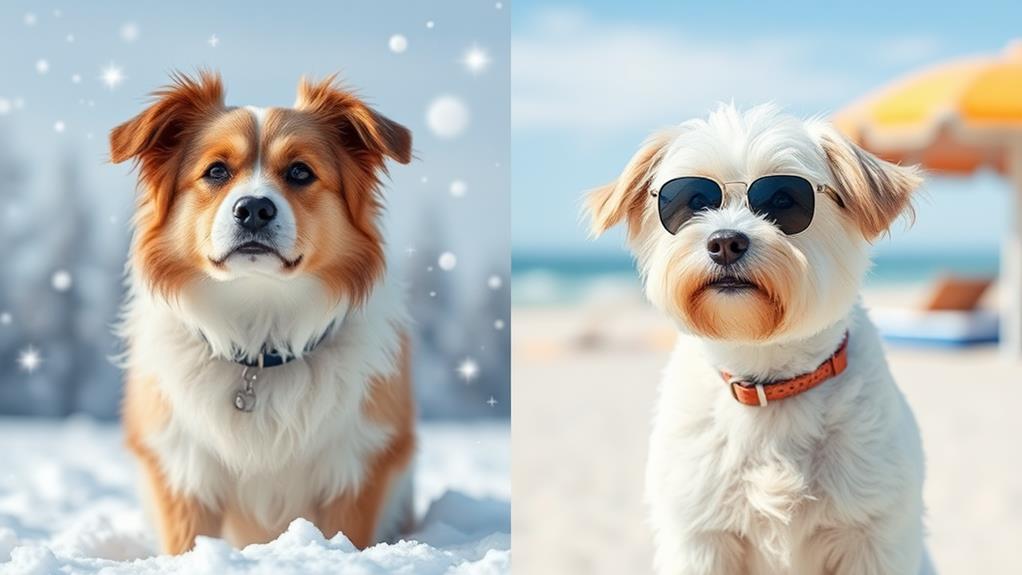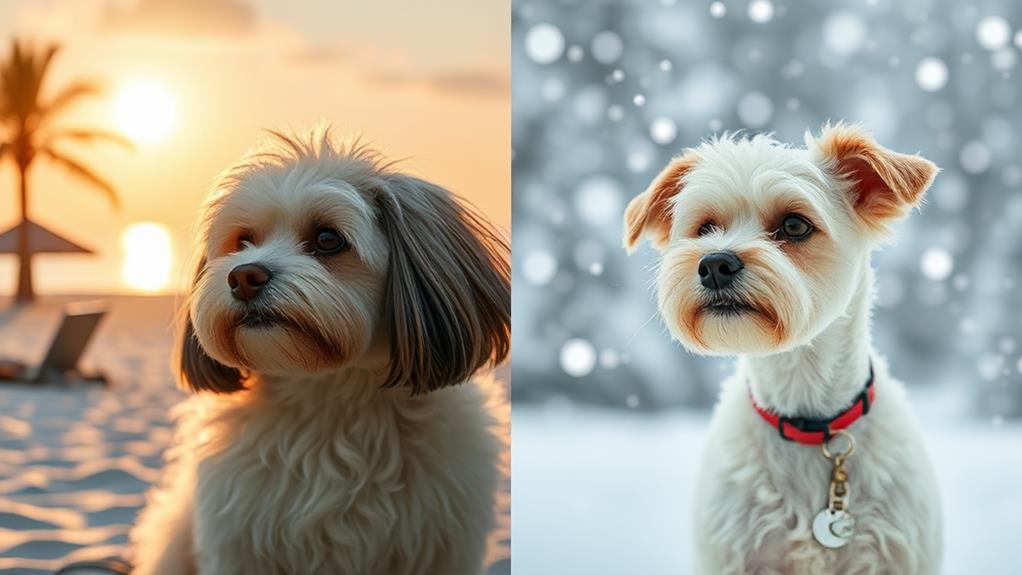Grooming your dog requires adjustments based on the climate where you live to keep them comfortable and healthy. In hot climates, brush regularly to reduce loose fur and bathe frequently to cool them down. For cold climates, focus on preventing matting and protecting paws from snow and ice. If you're near the coast, rinse off salt and sand while using moisturizing products. Humid areas need more frequent baths to prevent skin issues. Make sure to adjust grooming tools and techniques with season changes. There's plenty more to explore about each climate's specific needs!
Understanding Climate Impact

When it comes to grooming your dog, understanding climate impact is critical. The environment you live in influences your dog's coat, skin health, and overall grooming needs.
For instance, in humid climates, your dog might experience more matting and tangles due to moisture in the air. This can lead to skin irritations if you don't groom regularly. You'll need to adjust your grooming routine, focusing on brushing more frequently to keep their coat manageable and healthy.
In contrast, dry climates can cause your dog's skin to become flaky and itchy. You might find that your dog needs more moisturizing products and baths with hydrating shampoos to combat dryness. Additionally, you should pay special attention to their paws, as rough terrain can cause cracking or discomfort.
Seasonal changes also play a role in grooming. In colder months, you may want to use thicker grooming tools to prevent excess shedding, while in warmer months, lighter brushes can help keep your dog cool and comfortable. By recognizing your climate's specific needs, you can promote your dog's health and well-being.
Grooming for Hot Climates

Hot climates present unique grooming challenges that require attention to your dog's comfort and health. To keep your furry friend cool, regular grooming is essential. Start by brushing your dog's coat frequently to remove loose hair and reduce matting. This helps air circulate, keeping them cooler and more comfortable.
Consider a trim, especially for long-haired breeds. A shorter coat can help regulate body temperature, but avoid shaving them down completely, as their fur provides protection from sunburn and overheating. Look for breed-specific grooming tips, as some dogs have unique needs.
Bathing your dog more often in hot weather can also help. Use a gentle, dog-safe shampoo, and guarantee they're thoroughly dried afterward to prevent skin issues. Additionally, keep an eye on their paws; hot pavement can burn sensitive pads, so consider providing protective booties or limiting walks during the hottest parts of the day.
Grooming for Cold Climates

Grooming your dog in cold climates is imperative for their comfort and protection against the elements. Thick, double coats are common in many breeds, and while they provide insulation, they can also trap moisture and dirt. Regular brushing helps remove loose fur and debris, preventing matting and allowing their natural oils to distribute evenly.
Pay attention to your dog's paws, too. Snow, ice, and road salt can irritate their pads. Trim the fur between their toes to minimize ice buildup, and consider applying paw wax for extra safeguarding. After walks, wipe their paws to remove any harmful substances.
Bathing is another essential aspect of winter grooming, but don't overdo it. Too frequent bathing can strip their coat of natural oils, leading to dry skin. When you do bathe them, use a moisturizing shampoo designed for dogs.
Coastal Climate Considerations

Living near the coast brings unique grooming challenges for your dog that differ from those in colder climates. The salty air and sandy environment can wreak havoc on your dog's coat, so you'll need to adjust your grooming routine accordingly.
Regular brushing is essential to remove sand and debris, preventing matting, especially in breeds with longer hair.
You'll also want to pay attention to your dog's skin. Coastal climates can lead to dry skin due to sun exposure and salt. Consider using moisturizing shampoos and conditioners specifically designed for dogs to keep their skin hydrated. After beach outings, rinse your dog thoroughly to remove saltwater, which can irritate their skin.
Keep an eye on your dog's ears, too. The combination of moisture and sand can lead to infections. Regularly check and clean your dog's ears to keep them healthy.
Lastly, trimming your dog's fur can help reduce the amount of sand trapped in their coat. Shorter fur is easier to manage and can keep your dog cooler during warm coastal days. With these adjustments, you can help your dog thrive in a coastal climate while looking their best.
Humid Climate Grooming Tips

In humid climates, maintaining your dog's coat requires special attention to guarantee issues like matting and skin irritations don't occur. With high moisture levels in the air, your dog's fur can easily become tangled and damp, making regular grooming essential.
- Regular Brushing: Brush your dog's coat at least two to three times a week. This helps remove loose hair and dirt, preventing matting and allowing air to circulate through the fur.
- Frequent Baths: Bathe your dog more often than in drier climates, using a gentle, moisturizing shampoo. This helps remove sweat, dirt, and allergens that can cause skin irritation.
- Drying Techniques: After baths, make certain your dog is thoroughly dried with a towel or a pet-safe blow dryer. This prevents moisture from sitting on the skin and causing fungal infections.
- Inspect for Irritations: Regularly check your dog's skin for signs of irritation or infections, especially in areas where moisture can accumulate, like under the ears or between the toes.
Seasonal Coat Changes

Seasonal coat changes are a natural process for dogs, influenced by climate and breed. As the seasons shift, you might notice your dog shedding more in the spring and developing a thicker coat in the fall. This cycle helps them adapt to temperature changes, keeping them comfortable year-round.
In warmer months, your dog's undercoat may thin out, allowing for better airflow and preventing overheating. It's crucial to monitor this process and make sure your pup remains cool.
On the flip side, as temperatures drop, your dog's coat will likely become denser to provide insulation against the cold.
If you have a double-coated breed, expect more significant changes. The outer coat will shed while the undercoat grows in, providing essential warmth. During these transformations, regular brushing helps manage shedding and keeps their coat healthy.
Pay attention to your dog's specific needs based on their coat type and the climate you live in. Understanding these seasonal changes can help you better prepare for grooming sessions, making certain your dog stays comfortable and their coat remains in excellent condition throughout the year.
Tools and Techniques for Grooming

Understanding your dog's grooming needs during seasonal coat changes sets the stage for selecting the right tools and techniques. The right grooming tools can make the process easier, efficient, and more enjoyable for both you and your dog.
- Deshedding Tool: This is perfect for removing loose fur, especially during shedding season. It helps minimize mess around your home.
- Slicker Brush: Ideal for untangling mats and smoothing out your dog's coat. It works well on both long and short-haired breeds.
- Grooming Gloves: These not only help with fur removal but also provide a gentle massage, making grooming a pleasant experience for your dog.
- Clippers and Scissors: If your dog requires a trim or specific styling, clippers and scissors are essential for maintaining a neat appearance.
Frequently Asked Questions
How Often Should I Groom My Dog in Different Climates?
You should groom your dog regularly, adjusting based on climate. In hot weather, more frequent brushing helps reduce shedding. In cold climates, you might groom less often but guarantee their coat stays healthy and untangled.
Are There Specific Breeds That Adapt Better to Certain Climates?
Yes, certain breeds thrive in specific climates. For instance, Huskies handle cold well, while breeds like Chihuahuas prefer warmer environments. Knowing your dog's breed helps you provide the best care for their climate needs.
Can Grooming Affect My Dog's Health in Extreme Climates?
Grooming can be a game-changer for your dog's health in extreme climates! Regular brushing removes dirt and prevents matting, while proper baths keep their skin healthy. Don't underestimate how grooming can protect your furry friend!
Do Climate Changes Impact the Frequency of Shedding?
Yes, climate changes definitely impact shedding frequency. Warmer temperatures can increase shedding as dogs adjust to heat, while colder climates might trigger thicker coats. You should monitor your dog's shedding patterns throughout the seasons for ideal care.
What Are Signs My Dog Needs Grooming Adjustments for Climate?
You'll notice your dog panting excessively or developing matted fur when the climate changes. If their coat feels greasy, they're shedding more, or they seem uncomfortable, it's time to adjust their grooming routine.
Conclusion
In the end, the right grooming adjustments can make all the difference for your dog, no matter the climate. Imagine your pup bounding through the warm sand, their coat perfectly suited for the heat, or curling up in a cozy spot, well-prepared for a snowy day. With the right tools and techniques, you can guarantee your furry friend is comfortable and stylish year-round. So, what will you choose for your dog's next grooming adventure? The answer awaits!



